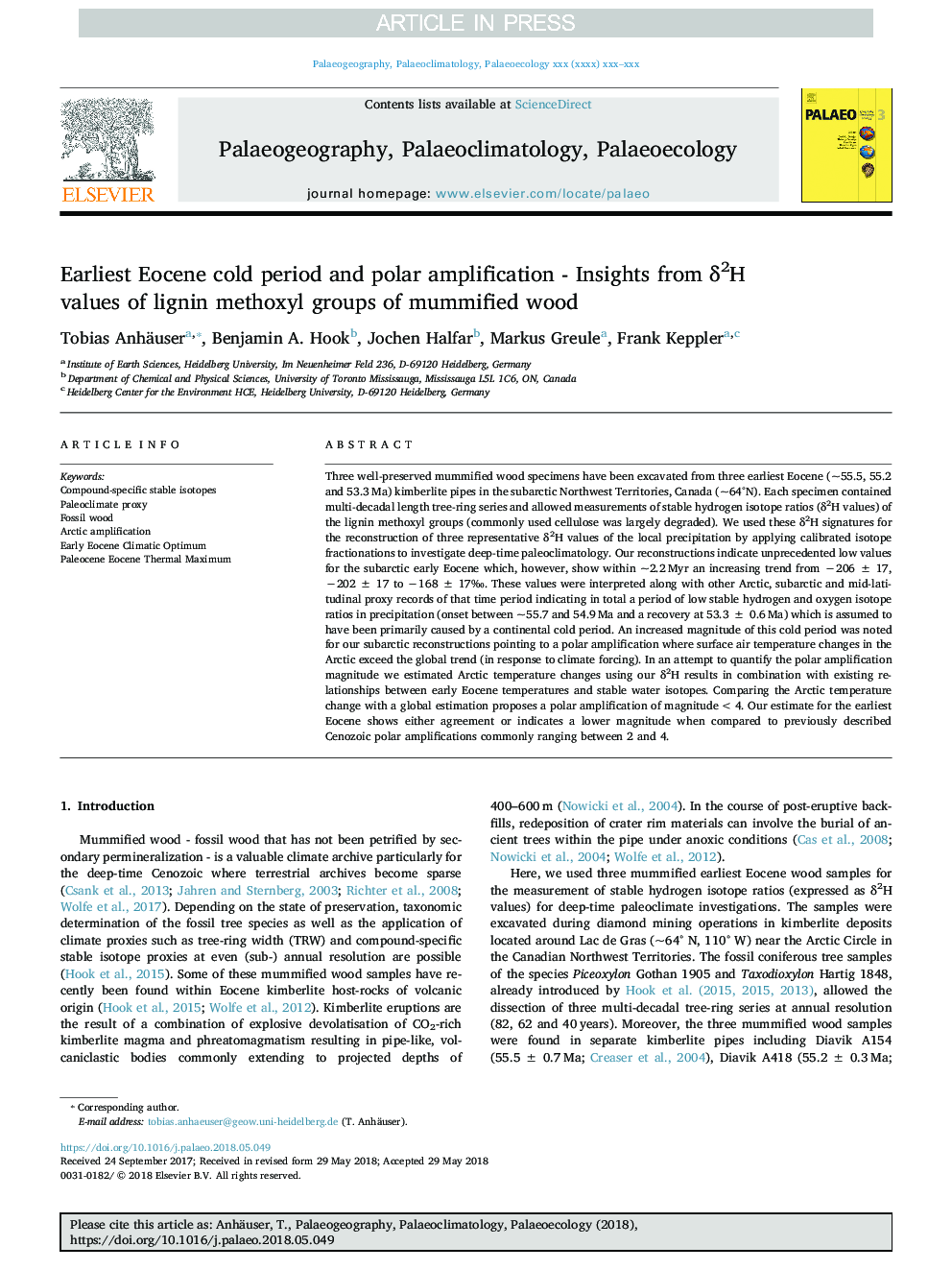| کد مقاله | کد نشریه | سال انتشار | مقاله انگلیسی | نسخه تمام متن |
|---|---|---|---|---|
| 8868164 | 1622087 | 2018 | 11 صفحه PDF | دانلود رایگان |
عنوان انگلیسی مقاله ISI
Earliest Eocene cold period and polar amplification - Insights from δ2H values of lignin methoxyl groups of mummified wood
دانلود مقاله + سفارش ترجمه
دانلود مقاله ISI انگلیسی
رایگان برای ایرانیان
کلمات کلیدی
موضوعات مرتبط
مهندسی و علوم پایه
علوم زمین و سیارات
فرآیندهای سطح زمین
پیش نمایش صفحه اول مقاله

چکیده انگلیسی
Three well-preserved mummified wood specimens have been excavated from three earliest Eocene (~55.5, 55.2 and 53.3â¯Ma) kimberlite pipes in the subarctic Northwest Territories, Canada (~64°N). Each specimen contained multi-decadal length tree-ring series and allowed measurements of stable hydrogen isotope ratios (δ2H values) of the lignin methoxyl groups (commonly used cellulose was largely degraded). We used these δ2H signatures for the reconstruction of three representative δ2H values of the local precipitation by applying calibrated isotope fractionations to investigate deep-time paleoclimatology. Our reconstructions indicate unprecedented low values for the subarctic early Eocene which, however, show within ~2.2â¯Myr an increasing trend from â206â¯Â±â¯17, â202â¯Â±â¯17 to â168â¯Â±â¯17â°. These values were interpreted along with other Arctic, subarctic and mid-latitudinal proxy records of that time period indicating in total a period of low stable hydrogen and oxygen isotope ratios in precipitation (onset between ~55.7 and 54.9â¯Ma and a recovery at 53.3â¯Â±â¯0.6â¯Ma) which is assumed to have been primarily caused by a continental cold period. An increased magnitude of this cold period was noted for our subarctic reconstructions pointing to a polar amplification where surface air temperature changes in the Arctic exceed the global trend (in response to climate forcing). In an attempt to quantify the polar amplification magnitude we estimated Arctic temperature changes using our δ2H results in combination with existing relationships between early Eocene temperatures and stable water isotopes. Comparing the Arctic temperature change with a global estimation proposes a polar amplification of magnitude <4. Our estimate for the earliest Eocene shows either agreement or indicates a lower magnitude when compared to previously described Cenozoic polar amplifications commonly ranging between 2 and 4.
ناشر
Database: Elsevier - ScienceDirect (ساینس دایرکت)
Journal: Palaeogeography, Palaeoclimatology, Palaeoecology - Volume 505, 15 September 2018, Pages 326-336
Journal: Palaeogeography, Palaeoclimatology, Palaeoecology - Volume 505, 15 September 2018, Pages 326-336
نویسندگان
Tobias Anhäuser, Benjamin A. Hook, Jochen Halfar, Markus Greule, Frank Keppler,